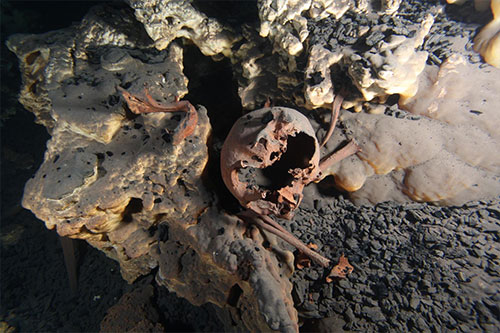
Early North Americans May Have Been More Diverse Than Previously Suspected
January 30, 2020
Ancient skulls from the cave systems at Tulum, Mexico suggest that the earliest populations of North America may have already had a high level of morphological diversity, according to a study published January 29, 2020 in the open-access journal PLOS ONE by Mark Hubbe from Ohio State University, USA, Alejandro Terrazas Mata from Universidad Nacional Autónoma de México, Mexico, and colleagues. The coastal, mostly-flooded limestone cave system in the city of Tulum in the Mexican state of Quintana Roo encompasses at least eight different sites with ancient human remains (approximately 13-8 kya). After dating and scanning four relatively well-preserved skulls retrieved from different sites within this cave network, Hubbe and colleagues used craniofacial morphology to compare these skulls with a reference dataset of worldwide modern human populations.
The skulls were from individuals who lived 9,000 to 13,000 years ago, in the late Pleistocene and early Holocene eras. The authors found unexpectedly high diversity among the skulls. While the oldest skull showed close morphological associations with modern arctic North Americans in Greenland and Alaska, the second-oldest skull demonstrated strong affinities with modern European populations--a new finding for early American remains using this type of reference comparison. Of the two remaining skulls, one appeared to show associations with Asian and Native American groups, while the other showed associations to arctic populations in addition to having some modern South American features. These findings complicate the story accepted until now, based on ancient skeletons analyzed from South America, which suggested the first settlers in the Americas were very similar, said Mark Hubbe, co-lead author of the study and professor of anthropology at The Ohio State University."The first Americans were much more complex, much more diverse than we thought," Hubbe said. "We have always talked about the settlement of the Americas as if North America and South America were the same. But they are different continents with different stories of how they were settled." Hubbe led the work with Alejandro Terrazas Mata of the Universidad Nacional Autónoma de México in Mexico. Their work was published yesterday (Jan. 29, 2020) in PLOS ONE. Archaeologists discovered the four skulls between 2008 and 2015 in submerged caves in the state of Quintana Roo, Mexico. At the time the four people were living, the caves were above sea level. The skulls were analyzed with a CT scan, which combines data from several X-rays to build a 3D image of each skull. The researchers analyzed the scans for specific landmarks on each skull and measured their positions on a 3D grid. They then compared the position of the coordinates with skulls from reference populations from all over the world to determine which populations the skulls most resembled. The oldest skull showed strong similarities to North American arctic populations, while the second-oldest skull was consistent with modern European populations. The third skull showed affinities with Asian and Native American groups and the fourth had affinities with arctic populations in addition to having some modern South American features. These skulls are important because compared to South America, relatively few ancient skeletons have been found in North America, Hubbe said. Between 300 and 400 skeletons that are more than 8,000 years old have been found in South America, compared to fewer than 20 in North America. "Not all the skulls we analyzed looked like the ones from South America. They are fairly distinct as far as the morphology," he said. The results suggest that the initial populations that ventured from Asia into North America had a high level of biological diversity, Hubbe said. For whatever reason, that diversity was reduced as humans dispersed into South America. "We always assumed that what was happening in South America was true in North America. Now we need to revise that. "We need to stop talking about the settlement of the Americas. We should talk about the settlement of North America and the settlement of South America as very different." Hubbe said the results also caution against trying to create overly simple narratives about human migration, especially in the Americas. "Whatever we thought about the settlement of the Americas is probably not the whole story. We still have a lot to learn."
On the Web:
Edited By Mary Kauffman, SitNews
Source of News:
|
|||||
